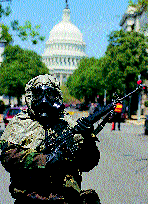Ebola hemorrhagic fever (Ebola HF) is a severe, often-fatal disease in humans and nonhuman primates (monkeys and chimpanzees) that has appeared sporadically since its initial recognition in 1976. The disease is caused by infection with Ebola virus, named after a river in the Democratic Republic of the Congo (formerly Zaire) in Africa, where it was first recognized. The virus is one of two members of a family of RNA viruses called the Filoviridae. Three of the four species of Ebola virus identified so far have caused disease in humans: Ebola-Zaire, Ebola-Sudan, and Ebola-Ivory Coast. The fourth, Ebola-Reston, has caused disease in nonhuman primates, but not in humans.
Symptoms
The signs and symptoms of Ebola HF are not the same for all patients. Time Frame Symptoms that occur in most Ebola patients Symptoms that occur in some Ebola patients Within a few days of becoming infected with the virus: high fever, headache, muscle aches, stomach pain, fatigue, diarrhea sore throat, hiccups, rash, red and itchy eyes, vomiting blood, bloody diarrhea Within one week of becoming infected with the virus: chest pain, shock, and death blindness, bleeding Researchers do not understand why some people are able to recover from Ebola HF and others are not. However, it is known that patients who die usually have not developed a significant immune response to the virus at the time of death.
Transmission
Infection with Ebola virus in humans is incidental -- humans do not "carry" the virus. Because the natural reservoir of the virus is unknown, the manner in which the virus first appears in a human at the start of an outbreak has not been determined. However, researchers have hypothesized that the first patient becomes infected through contact with an infected animal. After the first case-patient in an outbreak setting (often called the index case) is infected, humans can transmit the virus in several ways. People can be exposed to Ebola virus from direct contact with the blood and/or secretions of an infected person. This is why the virus has often been spread through the families and friends of infected persons: in the course of feeding, holding, or otherwise caring for them, family members and friends would come into close contact with such secretions. People can also be exposed to Ebola virus through contact with objects, such as needles, that have been contaminated with infected secretions.
Diagnosis
Diagnosing Ebola HF in an individual who has been infected only a few days is difficult because early symptoms, such as red and itchy eyes and a skin rash, are nonspecific to the virus and are seen in other patients with diseases that occur much more frequently. If a person has the constellation of symptoms and infection with Ebola virus is suspected, several laboratory tests should be done promptly. These include a blood film examination for malaria and a blood culture. If the suspected patient has bloody diarrhea, a stool culture should also be performed. Antigen-capture enzyme-linked immunosorbent assay (ELISA) testing, IgG ELISA, polymerase chain reaction (PCR), and virus isolation can be used to diagnose a case of Ebola HF within a few days of the onset of symptoms. Persons tested later in the course of the disease or after recovery can be tested for IgM and IgG antibodies; the disease can also be diagnosed retrospectively in deceased patients by using immunohistochemistry testing, virus isolation, or PCR.
Treatment
There is no standard treatment for Ebola HF. Currently, patients receive supportive therapy. This consists of balancing the patientís fluids and electrolytes, maintaining their oxygen status and blood pressure, and treating them for any complicating infections. During the Kikwit outbreak, eight patients were given blood of individuals who had been infected with Ebola virus but recovered. Seven of the eight patients survived. However, because the study size was small, and participants characteristics (including the fact that they were relatively young) predisposed them towards recovery, the efficacy of the treatment remains unknown.
Prevention
The prevention of Ebola HF in Africa presents many challenges. Because the identity and location of the natural reservoir of Ebola virus are unknown, there are few established primary prevention measures. If cases of the disease do appear, current social and economic conditions favor the spread of an epidemic within health-care facilities. Therefore, health-care providers must be able to recognize a case of Ebola HF should one appear. They must also have the capability to perform diagnostic tests and be ready to employ practical viral hemorrhagic fever isolation precautions, or barrier nursing techniques. These techniques include the wearing of protective clothing, such as masks, gloves, gowns, and goggles; the use of infection-control measures, including complete equipment sterilization; and the isolation of Ebola HF patients from contact with unprotected persons. The aim of all of these techniques is to avoid any personís contact with the blood or secretions of any patient. If a patient with Ebola HF dies, it is equally important that direct contact with the body of the deceased patient be prevented.
Links
Protection from Chemical Hazards
Wildpony ..... The Druidess Casts Her Spell
Biological Agents:
Anthrax/Botulism/Brucellosis/Campylobacteriosis/Cholera/Dengue Fever/Ebola Fever/E. Coli/Hanta Fever/Lassa Hemorrhagic Fever/Legionellosis/Marburg Hemorrhagic Fever/ Plague/Rift Valley Fever/Smallpox/Streptococcus/Tularemia/West Nile Fever

